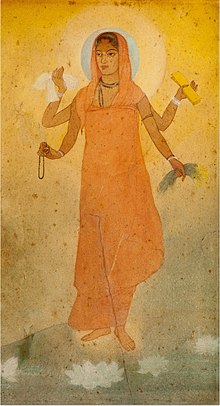
Back بهارات ماتا Arabic ভাৰত মাতা Assamese ভারত মাতা Bengali/Bangla Bharat Mata Esperanto Bharat Mata Spanish Bharat Mata Finnish Bharat Mata French ભારત માતા Gujarati भारतमाता Hindi バーラト・マータ Japanese
| Bharat Mata | |
|---|---|
 Bharat Mata by Abanindranath Tagore (1871–1951). | |
| Other names | Mother India |
| Animals | Lion |
| Symbols | Red or saffron-colored sari, national flag, lotus, lion |
| Temples | Few temples in India, first inaugurated in Varanasi in 1936 by Mahatma Gandhi |
Bharat Mata (Bhārat Mātā, Mother India in English) is a national personification of India (Bharat[1]) as a mother goddess. Bharat Mata is commonly depicted dressed in a red or saffron-coloured sari and holding a national flag; she sometimes stands on a lotus and is accompanied by a lion.[2]
The word Bharat Mata dates to late 19th century Bengal in modern literature. She was popularised by the Bengali language-novel Anandamath (1882), wherein she was depicted in a form inseparable from the Hindu goddesses Durga and Kali. After the controversial division of Bengal province in 1905, she was highlighted during the boycott of British-made goods organized by Sir Surendranath Bannerjee.[3] In numerous protest meetings, she was invoked in the rallying cry Vande Mataram (I bow to the mother).
Bharat Mata was painted as a four-armed goddess by Abanindranath Tagore in 1904, in the style associated with the Bengal School of Art, in a form derived from typical depictions of Hindu goddesses. This painting is displayed in the Victoria Memorial Museum in Kolkata. By the late 19th century, maps of India produced by the British Raj, and based on the Great Trigonometrical Survey, had become widely available. Over the background of a map, Bharat Mata was depicted on the cover of the poet Subramania Bharati's Tamil language-magazine Vijaya in 1909. In the decades following, she appeared throughout India in popular art: in magazines, posters, and calendars, becoming a symbol of Indian nationalism.
There are a handful of Bharat Mata temples in India. The first was inaugurated by Mahatma Gandhi in Varanasi in 1936. The temple has a large marble relief map of India on its floor, but originally lacked a murti (divine image used for worship). On its wall is displayed a poem written for the inauguration by the nationalist Hindi language-poet Maithili Sharan Gupt; it proclaims the temple to be open to all castes and religions. Most visitors to the temple are foreign tourists.[4] Indian Muslims and Sikhs have opposed the chanting of her name, because in Islam and Sikhism, God cannot be worshipped in human form.[5]
- ^ McGregor, R. S. (1993). "bhārat". Oxford Hindi-English Dictionary. Oxford University Press.
- ^ Visualizing space in Banaras: images, maps, and the practice of representation, Martin Gaenszle, Jörg Gengnagel, illustrated, Otto Harrassowitz Verlag, 2006, ISBN 978-3-447-05187-3
- ^ "History lesson: How 'Bharat Mata' became the code word for a theocratic Hindu state". 17 March 2016.
- ^ Singh, Ramendra (April 3, 2016), "A day in the life of Bharat Mata Mandir, Varanasi: Idol chatter", Indian Express, retrieved October 17, 2021
- ^ https://www.indiatimes.com/news/india/bharat-mata-ki-jai-controversy-continues-now-punjab-leader-says-won-t-chant-the-slogan-as-sikhs-don-t-worship-women-252470.html